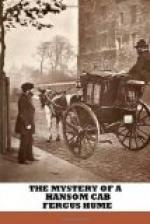These points in themselves were sufficient to show that the prisoner was innocent, but the evidence of the woman Pawlins must prove conclusively to the jury that the prisoner was not the man who committed the crime. The witness Brown had proved that the woman Rawlins had delivered a letter to him, which he gave to the prisoner and that the prisoner left the Club, to keep the appointment spoken of in the letter, which letter, or, rather, the remains of it had been put in evidence. The woman Rawlins swore that the prisoner met her at the corner of Russell and Bourke Streets, and had gone with her to one of the back slums, there to see the writer of the letter. She also proved that at the time of the committal of the crime the prisoner was still in the back slum, by the bed of the dying woman, and, there being only one door to the room, he could not possibly have left without the witness seeing him. The woman Rawlins further proved that she left the prisoner at the corner of Bourke and Russell Streets at twenty-five minutes to two o’clock, which was five minutes before Royston drove his cab up to the St. Kilda Police Station, with the dead body inside. Finally, the woman Rawlins proved her words by stating that she saw both the Post Office and Town Hall clocks; and supposing the prisoner started from the corner of Bourke and Russell Streets, as she says he did, he would reach East Melbourne in twenty minutes, which made it five minutes to two on Friday morning, the time at which, according to the landlady’s statement, he entered the house.
All the evidence given by the different witnesses agreed completely, and formed a chain which showed the whole of the prisoner’s movements at the time of the committal of the murder. Therefore, it was absolutely impossible that the murder could have been committed by the man in the dock. The strongest piece of evidence brought forward by the prosecution was that of the witness Hableton, who swore that the prisoner used threats against the life of the deceased. But the language used was merely the outcome of a passionate Irish nature, and was not sufficient to prove the crime to have been committed by the prisoner. The defence which the prisoner set up was that of an alibi, and the evidence of the witnesses for the defence proved conclusively that the prisoner could not, and did not, commit the murder. Finally, Calton wound up his, elaborate and exhaustive speech, which lasted for over two hours, by a brilliant peroration, calling upon the jury to base their verdict upon the plain facts of the case, and if they did so they could hardly fail in bringing in a verdict of “Not Guilty.”




